Posted by R. John Howe on 02-12-2006 04:18 AM:
The "Eagle Device"
Dear folks -
The "eagle" device in the so-called "Eagle Kazaks" in fact woven in Karabaugh
is so dramatic that it has attracted a lot of attention over the years.
Jerry mentions that some think it as sourced in a "coat of arms." Others say
probably a "rising sun." I mentioned that Christine Klose, a German student
of rug design and evolution has proposed that it is a "flower form" derived
from 17th century "vase" carpet designs. In her "Gereh" article she show a great
many photos but also gives a chart summarizing the evolution she sees. Here
that latter is:

I am hoping it is sufficiently legible for you to read.
One slightly different tack. Jerry notes that there is a second "eagle Kazak"
in this exhibition that he believes is older than the one I have shown here.
I cannot show you the piece in the exhibition, but here is one with the same
version of this design from Schurmann.

Note that there is only one "eagle" device in this version, but that there are
two "armature" devices top and bottom that Jerry says suggest a continuing design
with octagonal forms.
Klose actually shows that this is the case with the following detail from a
much larger 18th century piece of the "Caucasian dragon rug" variety.

Jerry said that he sold his "single eagle" version (the eagle on it is slightly
different and looks archaic) to another collector and has regretted it ever
since.
Regards,
R. John Howe
Posted by Tim Adam on 02-12-2006 09:15 AM:
Hi John,
The "coat of arms" and "rising sun" theories have no merit at all, have they?
I thought the ancestry of the 'sunburst' design is relatively well established.
Below are two more examples from the 18th century.
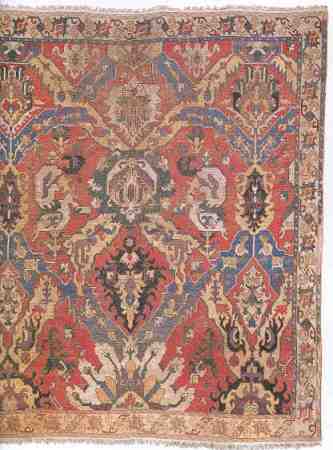 from Oriental Rugs from Pacific
Collections, Plate 231
from Oriental Rugs from Pacific
Collections, Plate 231
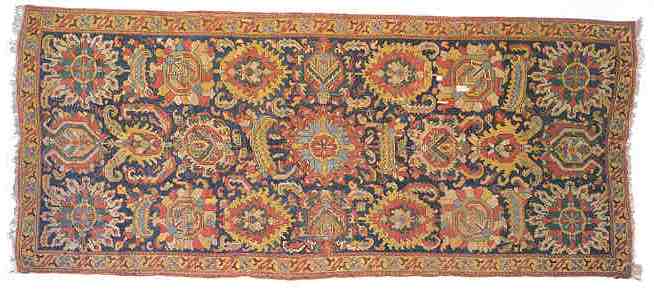 from Oriental Rugs from Atlantic
Collections, Plate 84
from Oriental Rugs from Atlantic
Collections, Plate 84
The 'sunburst' design is just one of several motives used in classical Caucasian
carpets, and wherever I look I tend to see floral, floral, floral (except for
the dragons perhaps). So, Kose's theory makes a lot of sense to me.
Tim
Posted by R. John Howe on 02-12-2006 10:39 AM:
Hi Tim -
Well, I'm hardly an arbiter because I haven't studied such designs closely myself.
In fact, I'm often somewhat put off by such analysis, but it is everywhere in
the rug literature.
Jerry's gallery label just clicked an association to the Klose article of which
I knew (not a lot of folks get Gereh).
There is a lot of controversy about the "Caucasian dragon carpets" that are
implicated in the analysis of the "eagle" device, including the question of
where they were woven. Wright and Wertime suggested a few years ago that the
dragon carpets aren't Caucasian at all and argued that there is a basis for
thinking they were woven in Tabriz.
I can't speak to what's settled in this entire area in part because it's my
sense that not much is.
Regards,
R. John Howe
Posted by Filiberto Boncompagni on 02-12-2006 11:24 AM:
Time to use again my good old Gans-Ruedin’s “Le Tapis du Caucase”.
The book has about twenty plates of classical Caucasians “Dragons” and “Palmette”
design from the 17th to the early 19th century.
I chose three plates showing further transitional designs from the ones presented
by Tim to the Chelaberd design.
Middle of 18th, from The Burrel Collection, Glasgow(page 51):
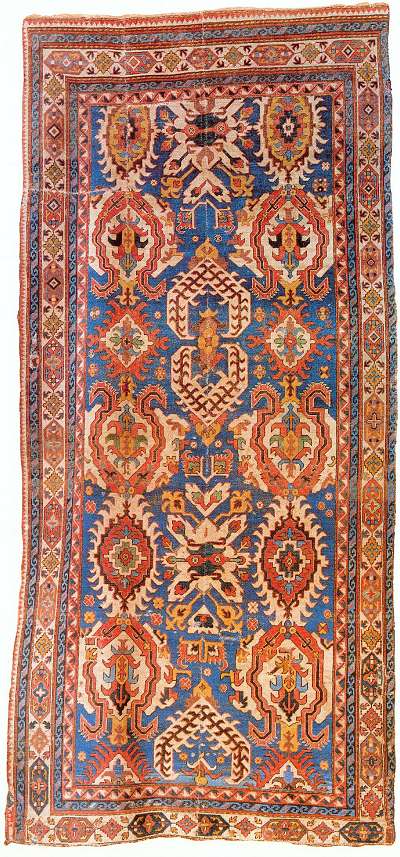
this is from the Textile Museum, Washington D.C. inv. # R.36.2.12, 18th C. (page
59:

And this if from the Thyssen-Bornemisza Collection, Castagnola 18th C. (page
56):

It's quite close to the Klose’s example (the pun is intentional).
It seems clear to me that Mrs. Klose is absolutely correct.
Regards,
Filiberto
Posted by Tim Adam on 02-12-2006 11:57 AM:
Hi Filiberto,
Does your book have examples of 17th century Vase carpets? Or John, maybe in
the Gereh article? So far we have shown the transition from Klose's group 3
to group 4 only. But she is making a lot more points.
Tim
Posted by Filiberto Boncompagni on 02-12-2006 12:33 PM:
Hi Tim,
No vase carpets on Gans-Ruedin, but there is one in Gantzhorn, from Harold Keshishian’s
Collection. By the way, Isn’t the "Gohar" rug a 17th century?
More interesting illustrations in Gantzhorn…
No time for scans now, sorry.
Regards,
Filiberto
Posted by Wendel Swan on 02-12-2006 02:08 PM:
Hello Filiberto,
It is a bit difficult to see how the Burrel rug fits into any analysis of the
transition of the "eagle" design since that rug has obviously been cut and shut
down the middle, removing more than half of the medallion. From the other motifs
in the rug and from what remains, I suspect that its "eagle" would rather closely
resemble that in the TM example.
Wendel
Posted by Wendel Swan on 02-12-2006 03:18 PM:
Hello Filiberto,
I'm sorry, but I meant to say that the "eagle" medallion in the Burrel rug would
likely resemble that in the Thyssen-Bornemisza Collection example, but I said
TM.
Wendel
Posted by Patrick Weiler on 02-12-2006 07:07 PM:
Flat weave version
There is a Caucasian "cover" in the current TM exhibit, Seldom Seen, that can
be viewed near the bottom of the image list at this link:
http://www.textilemuseum.org/about/imageListSeldomSeen.htm
It is 18th century and has the "eagle" design.
It has palmettes at the sides and an interesting medallion in the middle, one
not shown in the other examples here. I assume it is flatwoven, not pile.
Here is the required disclaimer from the TM web site:
Seldom Seen: Director's Choice from the Museum's Collections
Images are provided exclusively to the press, and only for purposes of publicity
for the duration of the exhibition at The Textile Museum. All published images
must be accompanied by the credit line provided and with copyright information,
if noted.
I am not "the press", so you had all better go over to the TM and view the exhibition!
Patrick Weiler
Posted by R. John Howe on 02-12-2006 09:33 PM:
Dear folks -
I thought Christine Klose's line drawings of particular devices provided a pretty
good basis for comparison but folks are asking for examples of actual carpets
that show her key evolutionary steps.
OK, but we need to remember that what we are talking about here is at most the
horizontal "a" and "b" levels in her table. Some of the other devices are apparently
similarly sourced but not our concern here.
Klose points explicitly to images that exemplify the main evolutionary steps
she sees in the progression of the "eagle" device from 17th century vase carpets.
Here is her example of a rug from the "blossom and sickle" group of 17th century
vase carpets.

And here is a closer look at a detail of this same piece.
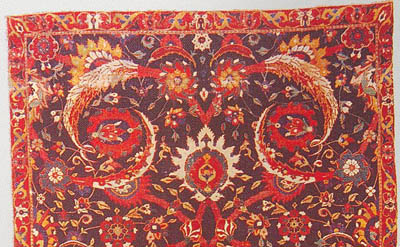
Klose describes the carpet illustrating her second evolutionary step as a Caucasian
"vase" carpet, woven at the beginning of the 18th century.

Here, again, is a closer look at a part of this piece.

We have already shown an example of Klose's third step in the design of the
"eagle" device, but here is another.

Klose describes the carpet above as a "Caucasian large-blossom" piece from the
18th century.
The fourth step you already know is the "eagle" designs we see on pieces such
as those in Jerry Thompson's exhibition. Klose's particular example is one with
a single "eagle" device and armatures top and bottom similar to the Schurmann
example I have provided above.
That should satisfy the request to provide actual carpet images for Klose's
four stages.
Regards,
R. John Howe
Posted by Filiberto Boncompagni on 02-13-2006 03:57 AM:
Hi Wendel
You are almost right. I mean, I saw that the rug was cut and resized, but I
didn’t realize how much it could have been reduced.
quote:
the "eagle" medallion in the Burrel rug would likely resemble that in the Thyssen-Bornemisza
Collection example
Yes, and we can virtually apply the same process to the Thissen-Bornemisza one:

In any case, I think the Burrel one is not terribly out of place here because
in my opinion it’s better drawn and has a blue field, instead of the red
one that became the norm with Chelaberd rugs. So it could be an early example.
That’s why I wrote you are “almost” right.
I’ll post another variation on the theme. Gantzhorn’s plate 481 From the Metropolitan
Museum of New York, age not mentioned:

It doesn’t hurt to show also the famous “Gohar” carpet because it’s related to
these designs as well:
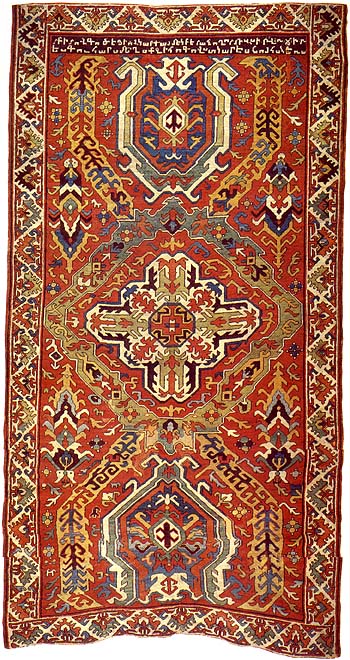
Gantzhorn says its date correspond to A.D. 1680. An Armenian site says it correspond
to 1700. Still, 1700 put it in the17th Cent. If it was 1701, THAT would have been
18th century.
Regards,
Filiberto
Posted by Filiberto Boncompagni on 02-13-2006 04:13 AM:
The TM’s cushion cover (thanks Patrick) and the Gohar rug remind me of Caucasian
embroideries.
Nothing new under the sun.
See this link to a “possibly Karabagh” embroidery, circa 1700. It mentions the
connection with Dragon' and `Blossom' carpets from Karabagh.
http://www.textile-art.com/tc96/14400.html
Look also at this one:
http://www.textile-art.com/tc96/15473.html
Regards,
Filiberto
Posted by R. John Howe on 02-13-2006 08:16 AM:
Dear folks -
Pat Weiler draws attention to a Caucasian embroidery with this "eagle" device
that is part of Dan Walker's new TM exhibition, "Seldom Seen: Director's Choice."
This piece is shown horizontally in the TM press package for which Pat provided
a link. In the exhibit, it is shown in a vertical orientation.

Cushion cover
Caucasus, 18th century
The Textile Museum 2.6
Acquired by George Hewitt Myers in 1915
It is quite spectacular and the image provided does not do full justice to its
colors.
In his walk-thru, Walker, described it as 18th century cottage industry production
and it was the only piece in the exhibit that he explicitly characterized as
"commercial."
Despite this a number of us in the walk-thru would have been prepared to walk
out with it unembarrassed as can be. It is, after all, one of only 28 pieces
selected from the TM's collection of 17,000.
Regards,
R. John Howe
Posted by Tim Adam on 02-13-2006 10:34 AM:
Hi John,
I agree with you. This cushion cover is quite spectacular. The best rendition
of the 'eagle' design I have seen. Would you have a larger scan of it?
What most of these 18th century carpets show is that the 'eagle' design is clearly
floral, a blossom shown from above, while other devices seem to show the same
blossom in a cross section.
Given this, I am not sure whether one can make the leap to the "blossom and
sickle" group of 17th century vase carpets, because the blossom there also seems
to be a cross-section.
Tim
Posted by R. John Howe on 02-13-2006 12:26 PM:
Hi Tim -
The image we have is what the TM has released. Filiberto has already applied
his not inconsiderable skills to attempt to get you a larger image without losing
definition.
What you see is what we have.
I can't debate Ms. Klose's thesis and haven't seen other comments on it.
Regards,
R. John Howe



 from Oriental Rugs from Pacific
Collections, Plate 231
from Oriental Rugs from Pacific
Collections, Plate 231 from Oriental Rugs from Atlantic
Collections, Plate 84
from Oriental Rugs from Atlantic
Collections, Plate 84










